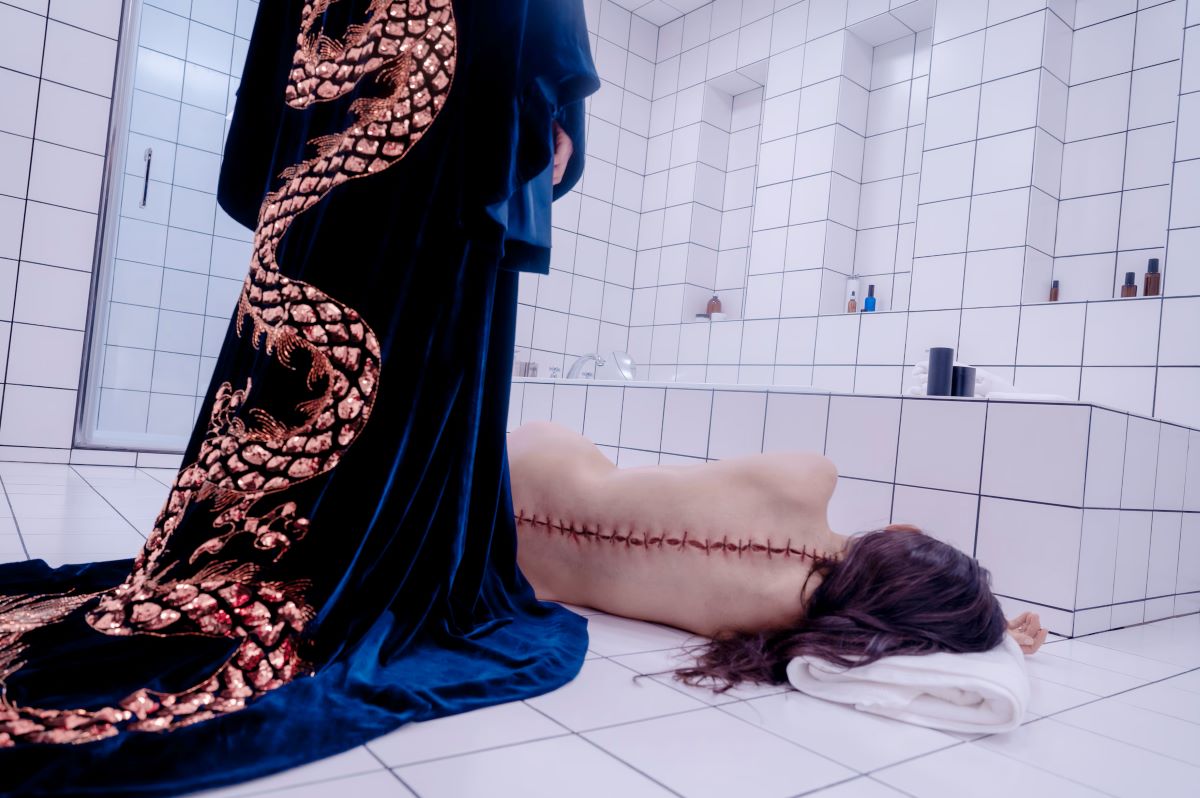The Substance
by Coralie Fargeat
You Can’t Survive the ‘80s
Elisabeth Sparkle was a famous actress, but at fifty, no one calls her to the set anymore, and she’s even dropped by a TV network where she hosts a fitness show. Deeply discouraged, she has a car accident, and in the hospital, a nurse gives her a tip: by calling a mysterious number, Elisabeth can become young and beautiful again…
Death Becomes Her (1992) by Zemeckis meets Society (1989) by Brian Yuzna, culminating in a monstrous fusion “à la” Tetsuo (1989) by Shinya Tsukamoto, but with a comedic twist: in her second feature film after a rape and revenge movie (Revenge, 2017), French director Coralie Fargeat brings a body horror comedy to the Croisette, a raucous farce that heavily references the ‘80s/’90s – raising the question if certain standards ever change – and not coincidentally resurrects one of the main stars of that period, Demi Moore. In The Substance, Moore plays Elizabeth Sparkle, an actress in her fifties who no longer shines (“to sparkle” means to shine, to glitter) and on her birthday, she is dropped by the TV network where she hosts a fitness show: the hateful producer (Dennis Quaid, also an emblematic actor of past decades) wants a refresh, which basically means a young, firm, and exciting woman instead of a beautiful middle-aged woman.
In the opening, Elisabeth’s rise and fall are shown brilliantly: a fixed, overhead shot tells the passage of time through the creation of her star on the Walk of Fame, complete with asphalt and setting in place, while later a girl, whose face we don’t see (obviously Elisabeth), goes to inaugurate it, greeting ecstatic fans. Initially, people take pictures of the ground sculpture, but slowly they start to wonder who Sparkle is, the weather erodes the stone, and eventually, people walk over it without a care, forgetting her. And so Elisabeth has aged, the greatest disaster for a woman and especially for a former diva with a perfect body who keeps a giant photo of herself at home. Luckily, after a shocking car accident, Elisabeth learns of a second chance: by calling a mysterious number, she can get directions and change her life. Alone, disheartened, and desperate, the former star can’t resist injecting herself with a substance that creates a new version of herself, more beautiful, sexier, and above all, much younger. From Demi Moore’s back emerges Margaret Qualley, the “double” of Elisabeth who chooses to call herself Sue. However, the process requires strict adherence to three rules, or there will be potentially disastrous consequences: the substance is injected only once; the original and the reproduced body must alternate every week, existing for seven consecutive days each (during that period, the other lies inert); and one must never forget that the original matrix (Elisabeth) and her creature (Sue) are actually the same person, not two separate entities, but absolutely interdependent. Sue, with warm, full, and erotic lips, obviously takes Elisabeth’s place for the new and more exciting “fitness”/twerking show on the network and pleases the slimy Dennis Quaid (who in The Substance is named Harvey: any reference to Weinstein is purely coincidental?), but she ends up having too much fun and being too successful, thus not respecting the binding schedule: Sue skips weeks, producing disastrous effects on Elisabeth. But if the two women are actually one, what happens to Sue herself if her original “matrix” is heavily mistreated? The film’s message is simple: men, who manage “production,” do not account for female aging (but theirs is accepted without issue) and even despise it. Women, in turn, do not accept aging and would do anything to stop time: Elisabeth could stop the experiment she subjected herself to at any moment and at the first sign of her double’s “insubordination,” but she doesn’t because she is the first to want to live only under the sweet wing of youth, which has miraculously reappeared and indirectly gives her joy through Sue. “I hate myself,” says the mature woman who, during the weeks she is herself, has nothing to do but watch TV and eat compulsively, while she can’t even go to dinner with a kind man (who doesn’t care at all that Elisabeth is no longer twenty) because she sees herself as ugly. The message is clear, and although it is a man (a slobbering Quaid, often portrayed in deformed close-ups) who deals in fresh bodies for the public’s pleasure, the woman who lives to be watched is complicit.
Organic mush, bodies splitting open, gushing blood, holes in the flesh, and other such delights are not in service of deep thought, cool body horror, or drama, but of a raucous and ironic film that is interesting to find in Competition and not in a side section of Cannes 77. Fargeat has sharp ideas and directs well, using overhead shots punctually, blatantly and lasciviously showcasing the plastic world of Sue/Margaret Qualley, whose nudes are as numerous as they are heavily processed in post-production, which is a sarcastic way of “replicating” in cinema the effects of plastic surgery, tickling precisely that voyeuristic/masturbatory gaze that The Substance discusses and which predominantly remains the pivot of male desire over the female. The “important” film references are plentiful and perhaps this is the most ancillary and deliberately mischievous thing in establishing a connection with the audience (especially festival-goers): from The Shining (one day it would be interesting to count how many films since 1980 reference Kubrick’s title) to Vertigo by Hitchcock, to absurd variations of Lynch (The Elephant Man, Mulholland Drive, Lost Highway) and of course Cronenberg (eXistenZ with its “bio-ports” and bodies sleeping while minds play in another dimension), up to a final creature that indeed seems to come from Tetsuo. Demi Moore, who in the end resembles Gollum from The Lord of the Rings, mocks herself (who certainly has not skimped on touch-ups to delay the inevitable physical change), but the reference to fitness inevitably brings to mind Jane Fonda who in the ’80s “taught” women to stay in shape even after the dreaded “forty” and not to give up in the face of age. Let’s tighten our glutes! Therefore, it is the Reagan era that is the inevitable conceptual reference for this very successful comedy – making the over two hours of runtime feel light – as if, in the end, we never really left that mindset and way of seeing things and relationships, and indeed, yuppism and its female counterpart are still here, stronger than ever though in disguise: not aging today is part of women’s empowerment, it is a conquest, a choice of freedom. But is it really so?
Elisa Battistini
Quinlan, May 20, 2024





